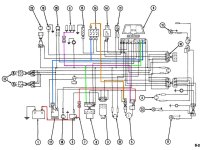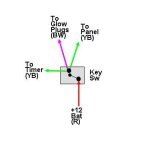Jim, regarding the new parts (circuit board and harness) I didn't have to splice anything, they were complete. BUT they didn't match the original in that there are 2 or 3 fewer pins in the connector on the new instrument harness. The guy at the parts counter siad it was the only one available for my tractor.
The service manual states: "The key switch supplies electrical power to the glow plugs and to the indicator lamp and timer relay through two seperate circuits."
The only wire coming from the fuse that keeps blowing is white/blue. I'll keep reading your posts and studying the wiring diagrams. Due to work schedule I'll won't be able to look at the tractor until the weekend. I'll post what I find out. Your help is very much appreciated.
Bob
Bob, finding out what is shorting that White Blue wire (coded WL) is the key to finding your problem. The pin on the end of the plug right next to the WL wire is Black (B). That's your ground wire as shown on the 2120 diagram. With the instrument panel removed, check continuity between the two pins in the connector. If you read zero ohms, your instrument panel is toast. If it reads open or a fairly high resistance, then your problem is probably external to the instrument panel and making contact through the plug only when connected. There's no real need to check continuity between those two pins in the connector that plugs into the inst pnl because when you disconnect, the fuse holds. Using the 2120 diagram as a go-by, you could check each pin's connections to individual components, but that is a VERY tedious process.
Did you ever mention what the value of the fuse is that you are blowing? I'm curious to know just how much current you are drawing. If it is a very low value fuse, I'd even be tempted to go up to a slightly larger value. Don't make any big steps in value. That's inviting smoke creation.
Yes, your svc man'l says there are separate circuits. Look at the diagram I've highlighted below. The red wire is the +12 vdc from the battery by way of the starter terminal. The power leaves the battery and goes up through the fusible link and over to the key switch. When you go to the preheat position, power leaves the switch on the pink line and goes up and over to the glow plugs (actually a black/white wire). Notice the green lines attached to the pink line on the diagram. I colored them green to make them stand out even though they are connected to the pink line. In the 2120 diagram, it says these wires are yellow/black. If you believe the schematic, somewhere between the key switch and glow plugs, there are two splices. In reality, the wiring is done like the small drawing after the schematic. On the back of the key switch, there are probably three separate wires. One to each component: 1) glow plugs, 2) timer, 3) inst pnl. I think that's what the service manual means by separate circuits.


Also, look at the color highlighted circuit for the fuse. Power comes up from the key switch on the amber highlighted wire. It leaves the fuse and goes to the alternator regulator and also over to the instrument panel. This is the circuit that is blowing the fuse and the source of your problems. It seems to have nothing to do with the glow plug circuit and is why I say the glow plug circuits are probably not the source of your problem.

